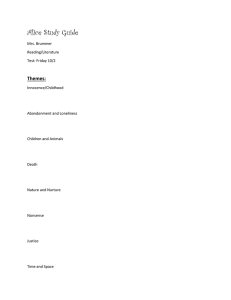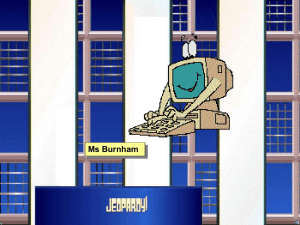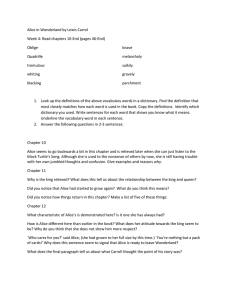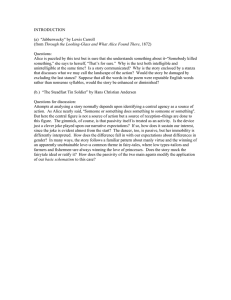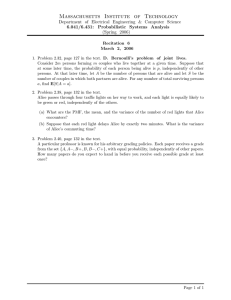Software Is Still Patentable, With Caveats
advertisement
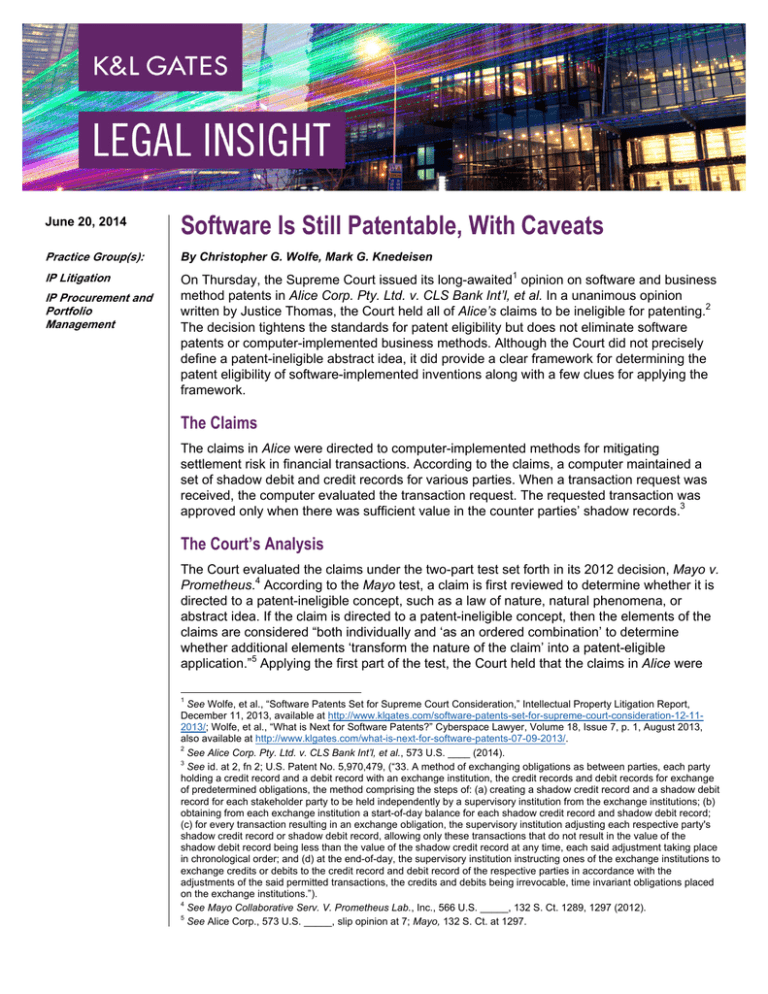
June 20, 2014 Software Is Still Patentable, With Caveats Practice Group(s): By Christopher G. Wolfe, Mark G. Knedeisen IP Litigation On Thursday, the Supreme Court issued its long-awaited1 opinion on software and business method patents in Alice Corp. Pty. Ltd. v. CLS Bank Int’l, et al. In a unanimous opinion written by Justice Thomas, the Court held all of Alice’s claims to be ineligible for patenting.2 The decision tightens the standards for patent eligibility but does not eliminate software patents or computer-implemented business methods. Although the Court did not precisely define a patent-ineligible abstract idea, it did provide a clear framework for determining the patent eligibility of software-implemented inventions along with a few clues for applying the framework. IP Procurement and Portfolio Management The Claims The claims in Alice were directed to computer-implemented methods for mitigating settlement risk in financial transactions. According to the claims, a computer maintained a set of shadow debit and credit records for various parties. When a transaction request was received, the computer evaluated the transaction request. The requested transaction was approved only when there was sufficient value in the counter parties’ shadow records.3 The Court’s Analysis The Court evaluated the claims under the two-part test set forth in its 2012 decision, Mayo v. Prometheus.4 According to the Mayo test, a claim is first reviewed to determine whether it is directed to a patent-ineligible concept, such as a law of nature, natural phenomena, or abstract idea. If the claim is directed to a patent-ineligible concept, then the elements of the claims are considered “both individually and ‘as an ordered combination’ to determine whether additional elements ‘transform the nature of the claim’ into a patent-eligible application.”5 Applying the first part of the test, the Court held that the claims in Alice were 1 See Wolfe, et al., “Software Patents Set for Supreme Court Consideration,” Intellectual Property Litigation Report, December 11, 2013, available at http://www.klgates.com/software-patents-set-for-supreme-court-consideration-12-112013/; Wolfe, et al., “What is Next for Software Patents?” Cyberspace Lawyer, Volume 18, Issue 7, p. 1, August 2013, also available at http://www.klgates.com/what-is-next-for-software-patents-07-09-2013/. 2 See Alice Corp. Pty. Ltd. v. CLS Bank Int’l, et al., 573 U.S. ____ (2014). 3 See id. at 2, fn 2; U.S. Patent No. 5,970,479, (“33. A method of exchanging obligations as between parties, each party holding a credit record and a debit record with an exchange institution, the credit records and debit records for exchange of predetermined obligations, the method comprising the steps of: (a) creating a shadow credit record and a shadow debit record for each stakeholder party to be held independently by a supervisory institution from the exchange institutions; (b) obtaining from each exchange institution a start-of-day balance for each shadow credit record and shadow debit record; (c) for every transaction resulting in an exchange obligation, the supervisory institution adjusting each respective party's shadow credit record or shadow debit record, allowing only these transactions that do not result in the value of the shadow debit record being less than the value of the shadow credit record at any time, each said adjustment taking place in chronological order; and (d) at the end-of-day, the supervisory institution instructing ones of the exchange institutions to exchange credits or debits to the credit record and debit record of the respective parties in accordance with the adjustments of the said permitted transactions, the credits and debits being irrevocable, time invariant obligations placed on the exchange institutions.”). 4 See Mayo Collaborative Serv. V. Prometheus Lab., Inc., 566 U.S. _____, 132 S. Ct. 1289, 1297 (2012). 5 See Alice Corp., 573 U.S. _____, slip opinion at 7; Mayo, 132 S. Ct. at 1297. Software Is Still Patentable, With Caveats directed to the abstract idea of “intermediated settlement.”6 Although the Court declined to “delimit the precise contours of the ‘abstract idea’ in this case,” it likened the claims to the claims at issue in Bilski v. Kappos, which were directed to “the basic concept of hedging.”7 Because both intermediated settlement and hedging are “fundamental economic practice[s] long prevalent in our system of commerce,” both are abstract ideas. Under the second part of the test, the Court held that “the mere recitation of a generic computer cannot transform a patent-ineligible abstract idea into a patent-eligible invention.”8 What Is New? While it can be viewed as a straightforward application of the Mayo and Bilski precedents, the decision in Alice clarified the patent-eligibility landscape in a number of ways. Most significantly, it confirms that the two-part framework from Mayo applies to abstract ideas, like the software claims in Alice, and to natural phenomena, like the medical method in Mayo. The Alice decision also clarifies and develops the Mayo framework in important ways regarding the definition of an abstract idea and what is necessary for a claim reciting an abstract idea to be patent-eligible. Although the Supreme Court in Alice declined to give a complete definition of an abstract idea, it provided examples. The Court suggested that “preexisting, fundamental truths that exist in principle apart from any human action” and “fundamental economic practices long prevalent in our system of commerce” are ineligible abstract ideas.9 Examples of “fundamental economic practice[s]” include the Bilski hedging claims, as well as the intermediated settlement claims from Alice.10 By definition, both of these examples lack novelty; fundamental truths are “preexisting” and fundamental economic practices are “long prevalent in our system of commerce.” The Court did not explicitly hold that all abstract ideas lack novelty, but the law may be heading in that direction. Regarding the second part of the Mayo framework, the Court made two important clarifications. First, it held that combining an abstract idea with a general purpose computer, without more, does not make the abstract idea patent-eligible,11 although the Court suggested that computer limitations could make an abstract idea patent-eligible if the claim “purport[s] to improve the functioning of the computer itself” or “effect[s] an improvement in any other technology or field.”12 Second, the Court settled a twenty-five-year-old conflict over whether a proper patent-eligibility analysis considers a claim element-by-element or as a whole. It held that both analyses are required, which is likely positive for patent applicants and owners because it affords multiple opportunities to show that a claim directed to an abstract idea is patent-eligible under the second part of the framework.13 6 See Alice Corp., 573 U.S. _____, slip opinion at 7. See Alice Corp., 573 U.S. _____, slip opinion at 8-9; Bilski v. Kappos, 561 U.S. 593 (2010). 8 See Alice Corp., 573 U.S. _____, slip opinion at 13. 9 See Alice Corp., 573 U.S. _____, slip opinion at 10 (internal citations omitted). 10 See id. at 9. 11 See id. at 13 (“[T]he mere recitation of a generic computer cannot transform a patent-ineligible abstract idea into a patent-eligible invention.”). 12 See id. at 15. 13 See Parker v. Flook, 437 U.S. 584, 594 (1978)([O]nce that algorithm is assumed to be within the prior art, the application, considered as a whole, contains no patentable invention.”); Diamond v. Diehr, 450 U.S. 175 (1981) (“In determining the eligibility of respondents’ claimed process for patent protection under § 101, their claims must be considered as a whole.”); Alice Corp., 573 U.S. _____, slip opinion at 7 (“To answer that question, we consider the 7 2 Software Is Still Patentable, With Caveats What Does It Mean For Patent Portfolios? Many non-business method software claims are likely to remain patent-eligible even in view of the Alice decision. As we predicted last year, claims that recite improvements to computer technology or non-computer physical features, such as sensors, motors, etc. are still very likely to be patent-eligible.14 Although not specifically mentioned in the Alice decision, claims where computer or technological implementation is essential are also likely to remain patenteligible.15 Claims directed to computer-implemented business methods are likely to be patent-eligible if they recite a non-conventional use of a computer or improvement to computer or other technology. Claims that recite a business method implemented by a generic computer are currently in a gray area because the Alice Court did not hold that all business methods or methods for organizing human activity are abstract ideas.16 There is an argument that claims of this type are patent-eligible if they are directed to something other than a “pre-existing fundamental truth” or a “fundamental economic practice.” Subsequent case law will color the gray area. elements of each claim both individually and ‘as an ordered combination’ to determine whether the additional elements ‘transform the nature of the claim’ into a patent-eligible application.”). 14 See Alice Corp., 573 U.S. _____, slip opinion at 15; Wolfe, et al., Cyberspace Lawyer at p. 8. 15 See Wolfe, et al., Cyberspace Lawyer at p. 8; SiRF Tech., Inc. v. Int’l Trade Comm’n, 601 F.3d 1319 (Fed. Cir. 2010); Research Corp. Techs., Inc. v. Microsoft Corp., 627 F.3d 859 (Fed. Cir. 2010). 16 See Alice Corp., 573 U.S. _____, slip opinion at 9-10, Alice Corp., U.S. _____, slip opinion at 1 (Sotomayor, J., concurring). 3 Software Is Still Patentable, With Caveats Authors: Christopher G. Wolfe christopher.wolfe@klgates.com +1.412.355.6798 Mark G. Knedeisen mark.knedeisen@klgates.com +1.412.355.6342 Anchorage Austin Beijing Berlin Boston Brisbane Brussels Charleston Charlotte Chicago Dallas Doha Dubai Fort Worth Frankfurt Harrisburg Hong Kong Houston London Los Angeles Melbourne Miami Milan Moscow Newark New York Orange County Palo Alto Paris Perth Pittsburgh Portland Raleigh Research Triangle Park San Diego San Francisco São Paulo Seattle Seoul Shanghai Singapore Spokane Sydney Taipei Tokyo Warsaw Washington, D.C. Wilmington K&L Gates comprises more than 2,000 lawyers globally who practice in fully integrated offices located on five continents. The firm represents leading multinational corporations, growth and middle-market companies, capital markets participants and entrepreneurs in every major industry group as well as public sector entities, educational institutions, philanthropic organizations and individuals. For more information about K&L Gates or its locations, practices and registrations, visit www.klgates.com. This publication is for informational purposes and does not contain or convey legal advice. The information herein should not be used or relied upon in regard to any particular facts or circumstances without first consulting a lawyer. © 2014 K&L Gates LLP. All Rights Reserved. 4


